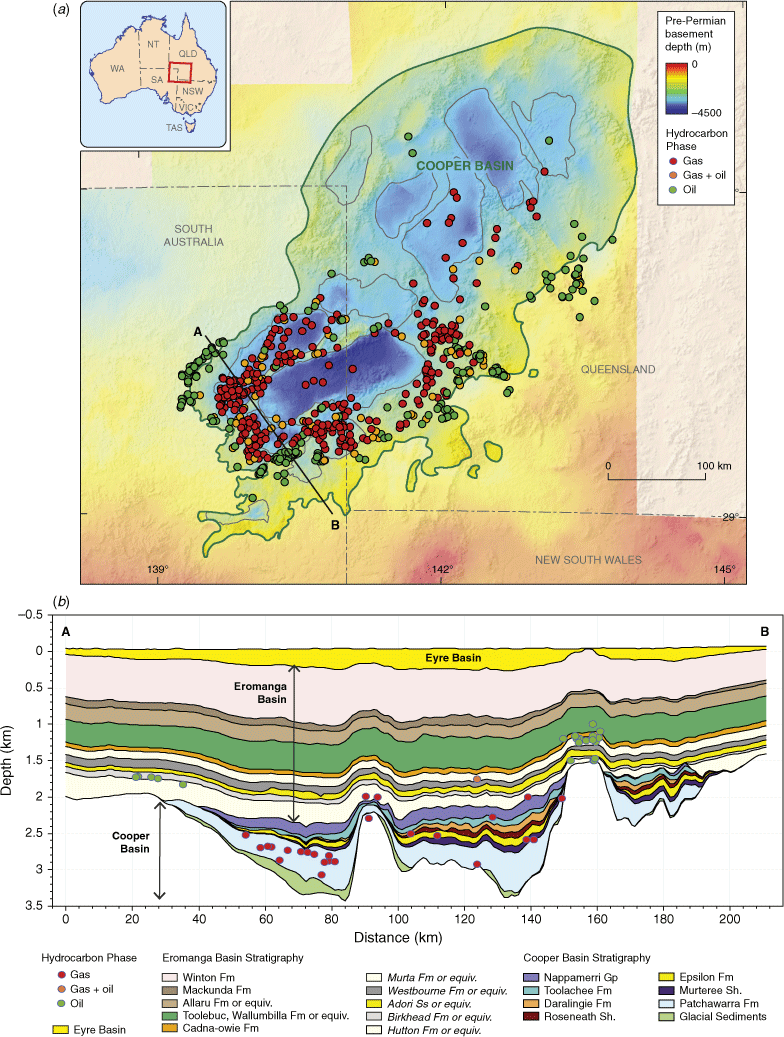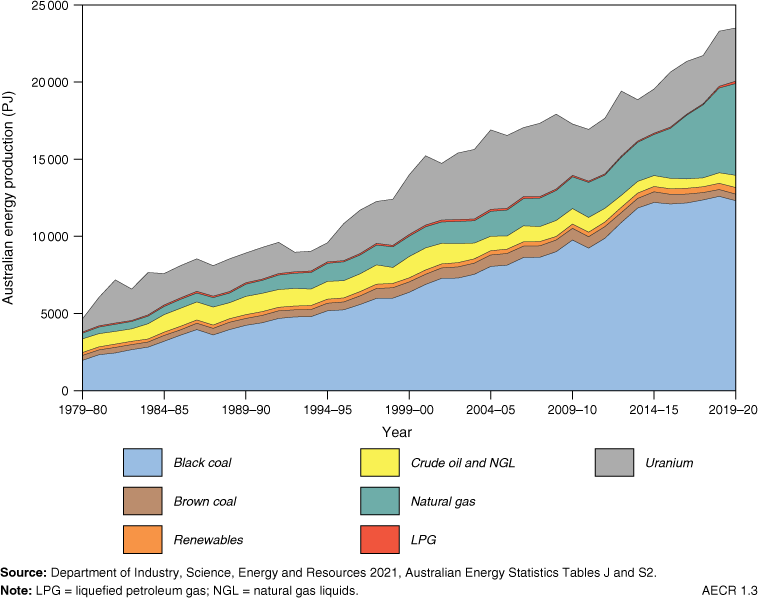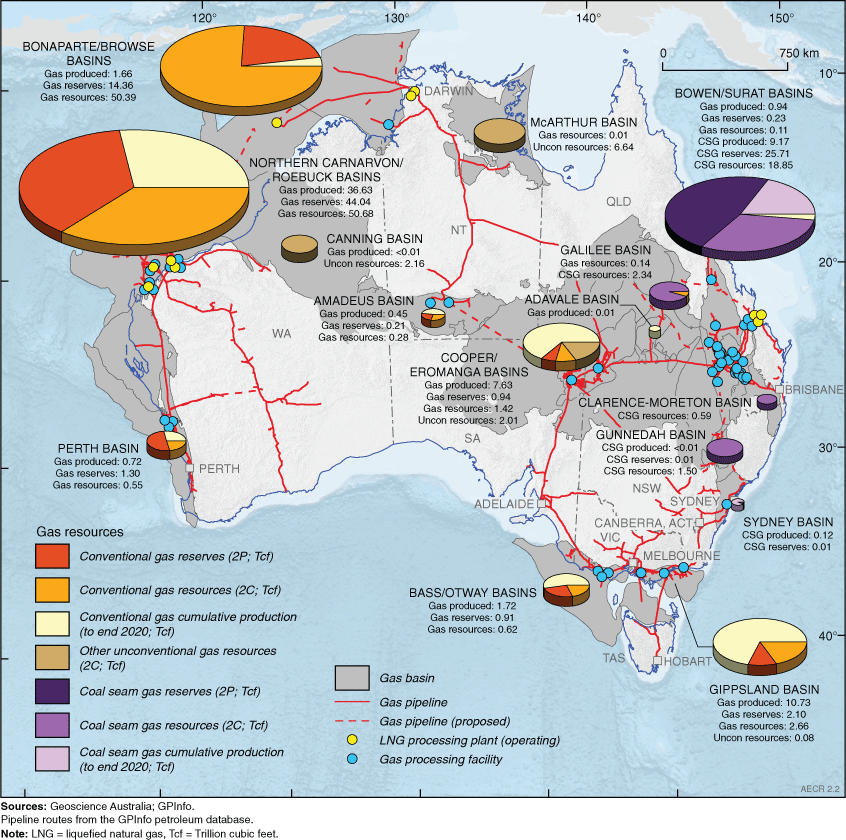Evaluating Australia’s energy commodity resources potential for a net-zero emission future
Thomas Bernecker A * , Barry E. Bradshaw A , Andrew J. Feitz A and Aleksandra A. Kalinowski AA Geoscience Australia, Minerals, Energy and Groundwater Division, GPO Box 378, Canberra, ACT 2601, Australia.
The APPEA Journal 62 S555-S561 https://doi.org/10.1071/AJ21091
Accepted: 3 May 2022 Published: 13 May 2022
© 2022 The Author(s) (or their employer(s)). Published by CSIRO Publishing on behalf of APPEA. This is an open access article distributed under the Creative Commons Attribution 4.0 International License (CC BY).
Abstract
Australia’s future energy production will increasingly be focused on developing clean energy resources to achieve the goal of net zero greenhouse gas emissions by 2050. To achieve this, an understanding of Australia’s natural gas resources and greenhouse gas storage potential is needed to facilitate the rapid implementation and expansion of low-emission technologies. While Australia continues to be a net gas exporter, additional volumes are needed to support future domestic manufacturing capabilities. These extra volumes can be produced from existing accumulations that are close to infrastructure or can be unlocked from highly prospective, yet underexplored regions. The coming decade will see a dramatic change in the energy mix that supports the Australian economy. A major driver will be the development of a hydrogen production industry, initially using fossil fuels with carbon capture and storage (CCS) until the cost of hydrogen production from renewable energy becomes more reliable and competitive. The expansion and projected lower costs of renewable energy generation via solar and wind will ultimately replace much of the non-renewable energies for hydrogen production. Geoscience Australia’s energy-related work program is focused on supporting Australia’s energy transformation assessments of untapped resource potential onshore include the evaluation of geologic hydrogen occurrences, the presence and suitability of subsurface salt horizons for hydrogen storage and the distribution of effective reservoir and seal fairways for underground carbon storage. While offshore, new data from Geoscience Australia’s sea-floor mapping project will improve the understanding of suitable areas for offshore wind farms. Results from these research activities are being made publicly available either through Geoscience Australia’s data portal and its data repository.
Keywords: carbon capture and storage, energy commodity resources, energy mix, enhanced oil recovery, hydrogen, hydrogen storage, natural gas resources, resource assessments.
Introduction
Consistent with Australia’s path to a low-carbon economy, Geoscience Australia is pursuing research activities that evaluate the occurrence and economic potential of energy commodity resources which developed will accelerate the nation’s emissions reduction while maintaining and improving Australia’s position as a global leader for the secure supply of energy. The evaluations in scope are subsurface energy resources, including natural gas, liquid hydrocarbons, hydrogen and the study of sedimentary sequences that may be suitable to store hydrogen as well as carbon dioxide (CO2).
The studies are complemented by spatially enabled resource assessments which will provide information about the overall volumetrics and producibility of hydrocarbons as well as the identification of optimal locations for CO2 injection and storage. Apart from evaluating energy commodity resources, Geoscience Australia is also involved in a major seabed mapping project. Although the project is predominantly aimed at spatial variations of marine biotopes, it will also provide an improved understanding of the physical and geomorphological features of Australia’s shallow marine environments, which can be used to inform the planning of offshore wind farms.
Australia’s energy commodity resources base
Australia has vast amounts of high-quality resources that are utilised for energy generation. These resources are widely distributed across the continent and along Australia’s offshore regions. Most of these resources are expected to last for many decades to come, even if production levels increase. Australia continues to be a net exporter of energy commodity resources which is mainly driven by the large resource bases of black coal, natural gas and uranium.
As shown in Fig. 1, the amount of energy produced domestically from non-renewable energy rose in 2019–2020 to a historical high, with natural gas and to a lesser extent crude oil and natural gas liquids being the main drivers of the growth. However, during this period, even though coal production (black and brown) remained the largest contributor to energy production in Australia production for both fell, 2% and 4% respectively (Department of Industry, Science, Energy and Resources 2021). Uranium is produced almost entirely to meet export demand with only a small amount used for domestic research and medical purposes. Uranium production has declined in recent years in the lead up to the closure of the Ranger Mine in January 2021, but is expected to increase in the coming years with nuclear power being reconsidered globally as an alternative clean energy source. Production of crude oil has been in decline since 2010 leading to an increased dependence on importations. Production from renewable sources, including wind and solar, only contributes a small percentage (1.4%) to the total amount of energy produced in Australia, but has grown on average by 4.0% per annum over the past decade and will become an increasingly important part of energy production in coming years (Geoscience Australia 2022). In terms of electricity generation, renewables provided 32% in 2021 (Clean Energy Council 2022). As coal-fired power stations are retired in the coming years and decades, renewables will continue to be an increasingly important part of energy production, Jointly with, the development of Australia’s existing natural gas resources and the ‘yet to find’ prospective resources, the sustainable growth of renewable energy resources will continue to grow in its importance as a component of Australia’s long-term energy security.
Volumetrically, Australia’s largest accumulations of conventional natural gas resources occur along the northern continental margin (Fig. 2). The Northern Carnarvon Basin has been the most prolific of Australia’s gas basins, having produced 36.63 Tcf of gas since the first commercial development in the mid-1980s. Large gas fields were discovered in the Browse Basin between 1980s and 2000 and production commenced in 2019 when the Ichthys pipeline was completed. The Bonaparte Basin also hosts many large fields that await development; however, only the Blacktip (Petrel Sub-basin) and Bayu-Undan (former Joint Petroleum Development Area) fields are in production. Along the southern margin, the Gippsland Basin has been the premier gas producing province over many decades but the known resources are now in rapid decline. The offshore Otway Basin has emerged as a high-volume gas province with recent commercial discoveries in the Shipwreck Trough.
In onshore Australia, the Cooper Basin is the main conventional gas producing province. Small amounts of gas have been produced from the onshore Otway Basin, while in the west, the onshore Perth Basin has recently become established as a new conventional gas province with large discoveries significantly expanding the known resource potential.
Unconventional gas resources play an important role in Queensland, where coal seam gas (CSG) production in the Bowen (Permian Coal Measures) and Surat (Jurassic Walloon Coal Measures) Basins represents more than 90% of the total gas produced in the state (Business Queensland 2020). In addition, significant resources of other unconventional gas (shale gas, tight gas, basin centred gas) have been identified in several onshore basins (Fig. 2), in which the sedimentary host rocks range in age from the Proterozoic (Beetaloo Sub-basin, McArthur Basin) to Early and mid-Paleozoic (Canning Basin), Permian–Triassic (Cooper Basin) and Early Cretaceous (Gippsland Basin).
Hydrogen production will be a major contributor to the decarbonisation of energy, transport and manufacturing industries. Hydrogen from geological sources (geologic hydrogen) has been found in Australian natural gas samples (Boreham et al. 2021), gaining an increasing share of exploration investment and activity globally. If found in commercially exploitable quantities, geologic hydrogen could potentially support the transition to a low-carbon economy. The origins of geologic hydrogen are varied (Boreham et al. 2021) and is found in shallow reservoirs encompassing igneous, metamorphic and sedimentary rocks. It is also thought to be a prominent component of the lower mantle‒core. Natural gas linked with CCS can also be used for hydrogen production and its implementation is partly supported by the newly released offshore acreage for the exploration for suitable CO2 injection and storage sites.
Unlocking future energy commodity resources
In order to provide the energy needed to establish a hydrogen industry and to expand the network of renewable energy production facilities, significant volumes of existing, reliable fuel types are required in the short term. In respect of limiting emissions, the most suitable is natural gas. At present, approximately 75% of Australia’s currently produced gas is converted to LNG and exported. New gas resources need to be unlocked to maintain Australia’s LNG export industry while meeting future increases in domestic gas demand.
Geoscience Australia’s energy work program includes several multidisciplinary studies aimed at identifying and assessing the untapped potential of those energy commodity resources that will be utilised to achieve the net-zero emission target. A majority of the studies are focused on underexplored onshore basins of the Pedirka, Simpson, Amadeus, Officer, Adavale, North Bowen and Galilee Basins and include regional petroleum system modelling combined with industry standard play-based exploration methodologies, to provide an assessment of both conventional and unconventional hydrocarbon resources. The workflows have also been modified to evaluate the distribution of effective reservoir and seal fairways to identify suitable locations for future CO2 storage. The objective of this work is to produce spatially enabled and risked resource estimates to provide government and industry stakeholders with decision making tools to address the regions’ energy resources and CCS potential.
Large volumes of hydrogen may require underground storage in order to manage supply and demand for domestic use or for export. Geoscience Australia’s hydrogen program investigates the occurrence of suitable underground storage sites, such as subsurface salt accumulations and depleted gas reservoirs. This will assist with better infrastructure planning for the Australian hydrogen industry. Another component of the hydrogen project is assessing the potential for hydrogen production through the use of geothermal energy from deep-seated hot sedimentary aquifers.
An innovative approach to carbon capture, usage and storage (CCUS) is being taken with the investigation of residual oil zones (ROZ) from which liquid hydrocarbons can be liberated (enhanced oil recovery; EOR) via the injection and subsequent storage of carbon dioxide. Historically, CO2-EOR was used to maximise oil recovery while minimising the amount of injected CO2 due to the limited availability and high cost of CO2. The net amount of CO2 emitted from the produced oil would therefore be greater than the amount stored. It is possible, however, to find examples where the amount of CO2 used for EOR is equal to or larger than the CO2 produced through the life-cycle of the resulting oil (referred to as CO2-EOR+) (Tenthorey et al. 2021). In collaboration with CSIRO, the project aims to understand whether technically accessible and potentially commercially viable oil resources can be found in ROZ in Australia. The initial focus of this study is the Cooper Basin (Fig. 3), which is proximal to existing hydrocarbon infrastructure, providing access to CO2 as well as to extensive high-quality geological and production data (Kalinowski et al. 2022; Tenthorey et al. 2022).

|
Apart from investigating energy commodity resources in sedimentary basins, Geoscience Australia’s marine program includes a national seabed mapping coordination initiative known as AusSeabed (http://www.ausseabed.gov.au/). The AusSeabed initiative coordinates seabed data as well as collection efforts in Australian waters and improves data access. Data types include physical parameters such as bathymetry, sediment sorting, acoustic reflectivity, shallow subsurface, substrate type and geomorphology. This information is used to provide a concise understanding of the controls on biodiversity marine environments and will provide improved controls on the selection of optimal sites for offshore wind farms.
Conclusions
Australia’s’ energy production is undergoing extensive transformation and diversification to support the decarbonisation of the nation’s economy, and global alignment with net-zero emission targets and Australia’s goal of net-zero emissions by 2050. In support of these efforts, Geoscience Australia is undertaking a diverse range of national-scale studies to identify ‘yet-to-find’ hydrocarbon resources; areas with potential hydrogen resources (naturally occurring, green and blue); residual oil zones that can be produced while utilising and storing CO2; and areas with high potential for underground storage of hydrogen and CO2.
The work contributes to the expansion of Australia’s energy commodity resource base. The development of untapped energy resource accumulations will require an expansion of existing infrastructure and/or the creation of new networks. This is an important driver for increasing Australia’s resource wealth while decarbonising the economy in a timely manner.
Geoscience Australia continues to provide easy access to open file data as well as to the newly acquired and generated data sets of current ongoing projects. These data sets are routinely made available as soon as they have been quality controlled in preparation for public release.
Data availability
Data that support this study will be shared upon reasonable request to the corresponding author.
Conflicts of interest
All authors confirm there are no conflicts of interest.
Declaration of funding
No funding from external organisations was received for this research.
Acknowledgements
The authors wish to thank Ryan Owens and Jeremy Iwanec for their constructive reviews, and Silvio Mezzomo and Chris Evenden for figure preparation. The authors also wish to acknowledge the input from Kim Picard who provided updates on the seabed mapping project. This extended abstract is published with the permission of the Chief Executive Officer, Geoscience Australia.
References
Boreham CJ, Edwards DS, Czado K, Rollet N, Wang L, van der Wielen S, Champion D, Blewett R, Feitz A, Henson PA (2021) Hydrogen in Australian natural gas: occurrences, sources and resources. The APPEA Journal 61, 163–191.| Hydrogen in Australian natural gas: occurrences, sources and resources.Crossref | GoogleScholarGoogle Scholar |
Business Queensland (2020) Petroleum and coal seam gas. Available at www.business.qld.gov.au/industries/mining-energy-water/resources/petroleum-energy/outlook-statistics/petroleum-gas [Accessed 26 April 2022]
Clean Energy Council (2022) ‘Clean Energy Australia Report 2022.’ (Clean Energy Council) Available at https://assets.cleanenergycouncil.org.au/documents/resources/reports/clean-energy-australia/clean-energy-australia-report-2022.pdf [Accessed 26 April 2022]
Department of Industry, Science, Energy and Resources (2021) Australian Energy Statistics 2021 Energy Update Report. Available at https://www.energy.gov.au/publications/australian-energy-update-2021 [Accessed 26 April 2022]
Geoscience Australia (2022) ‘Australia’s Energy Commodity Resources, 2022 Edition.’ (Geoscience Australia: Canberra)
Hall LS, Palu TJ, Murray AP, Boreham CJ, Edwards DS, Hill AJ, Troup A (2019) Hydrocarbon prospectivity of the Cooper Basin, Australia. AAPG Bulletin 103, 31–63.
| Hydrocarbon prospectivity of the Cooper Basin, Australia.Crossref | GoogleScholarGoogle Scholar |
Kalinowski A, Tenthorey E, Seyyedi M, Clenell MB (2022) The search for new oil and CO2 storage resources: residual oil zones in Australia. The APPEA Journal 62, 281–293.
| The search for new oil and CO2 storage resources: residual oil zones in Australia.Crossref | GoogleScholarGoogle Scholar |
Tenthorey E, Taggart I, Kalinowski A, McKenna J (2021) CO2-EOR+ in Australia: achieving low-emissions oil and unlocking residual oil resources. The APPEA Journal 61, 118–131.
| CO2-EOR+ in Australia: achieving low-emissions oil and unlocking residual oil resources.Crossref | GoogleScholarGoogle Scholar |
Tenthorey E, Kalinowski A, Seyyedi M, Jackson S, Clennell B (2022) CO2 EOR-storage methodology in residual oil zones. Record 2022/03 Geoscience Australia, Canberra.
| Crossref | [Accessed 26 April 2022]

Thomas (Tom) Bernecker is a sedimentologist/petroleum geologist who holds an MSc from the University of Aachen (RWTH), Germany and a PhD from Melbourne’s La Trobe University. Tom’s early work focused on the development of models for siliciclastic and carbonate depositional systems in NW Europe and in Australia. After a lectureship at the University of Melbourne, Tom joined the Victorian Department of Natural Resources and Energy where his work was focused on the hydrocarbon prospectivity of the Gippsland and Otway Basins. Tom joined Geoscience Australia as the team leader for the onshore hydrocarbon project in 2007 and from 2009 onwards has managed the offshore acreage release program, including the promotion of investment opportunities in Australia’s oil and gas sector. Tom is currently the Director of the Energy Resources Advice and Promotion section in GA’s Minerals, Energy and Groundwater division. He is a member of PESA, SEPM and SEAPEX. |

Dr Barry Bradshaw is a Geoscientist with over 30 years experience undertaking geological and geophysical studies and play-based prospectivity studies for conventional and unconventional hydrocarbon resources, geological storage projects and sediment-hosted mineral deposits. Barry is currently employed as the Energy Resources and Advice activity leader at Geoscience Australia, and has previously worked as a Principal Geologist at CGSS consultants, Senior Research Scientist at AGSO/Geoscience Australia and Research Scientist at Texas A&M University (USA). Barry graduated from the University of Sydney in 1988, and completed a PhD in Earth Sciences at the University of Waikato (New Zealand) in 1991. |

Andrew Feitz is an environmental engineer and Director of Low Carbon Geoscience and Advice at Geoscience Australia. He holds a PhD from the University of New South Wales (UNSW) and worked as a senior researcher in air and water treatment technologies at UNSW and the Karlsruhe Institute of Technology (Germany). He moved to Canberra in 2008 and joined Geoscience Australia where he developed and led a research program to evaluate monitoring techniques for geological storage of carbon dioxide. Andrew leads the geological storage team in Geoscience Australia and Geoscience Australia’s efforts supporting implementation of the National Hydrogen Strategy. |

Aleksandra Kalinowski is a senior geoscientist at Geoscience Australia and holds an undergraduate degree in geology from ANU and a PhD from UNSW. She has worked extensively on CCUS including undertaking geological assessments for CO2 storage and working on technical and policy aspects of CCS at MIT’s Laboratory for Energy and the Environment and Harvard University’s Kennedy School of Government. Aleks continues to focus on low-emission energy resources, most recently focusing on geological storage combined with utilisation through CO2-enhanced oil recovery, as well as hydrogen and geothermal energy. |




